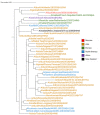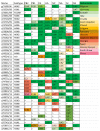Monitoring of Avian Influenza Viruses and Paramyxoviruses in Ponds of Moscow and the Moscow Region
- PMID: 36560628
- PMCID: PMC9781285
- DOI: 10.3390/v14122624
Monitoring of Avian Influenza Viruses and Paramyxoviruses in Ponds of Moscow and the Moscow Region
Abstract
The ponds of the Moscow region during the autumn migration of birds are a place with large concentrations of mallard ducks, which are the main hosts of avulaviruses (avian paramyxoviruses) and influenza A viruses (IAV). The purpose of this study was the determination of the biological diversity of IAV and avulaviruses isolated from mallards in Moscow's ponds. A phylogenetic analysis of IAV was performed based on complete genome sequencing, and virus genomic reassortment in nature was studied. Almost all IAV genome segments clustered with apathogenic duck viruses according to phylogenetic analysis. The origin of the genes of Moscow isolates were different; some of them belong to European evolutionary branches, some to Asian ones. The majority of closely related viruses have been isolated in the Western Eurasian region. Much less frequently, closely related viruses have been isolated in Siberia, China, and Korea. The quantity and diversity of isolated viruses varied considerably depending on the year and have decreased since 2014, perhaps due to the increasing proportion of nesting and wintering ducks in Moscow.
Keywords: avian influenza; circulation; diversity.
Conflict of interest statement
The authors declare no conflict of interest.
Figures



References
-
- Kabilov M.R., Alikina T.Y., Yurchenko K.S., Glushchenko A.V., Gunbin K.V., Shestopalov A.M., Gubanova N.V. Complete Genome Sequences of Two Newcastle Disease Virus Strains Isolated from a Wild Duck and a Pigeon in Russia. Genome Announc. 2016;4:e01348-16. doi: 10.1128/genomeA.01348-16. - DOI - PMC - PubMed
Publication types
MeSH terms
LinkOut - more resources
Full Text Sources
Medical

